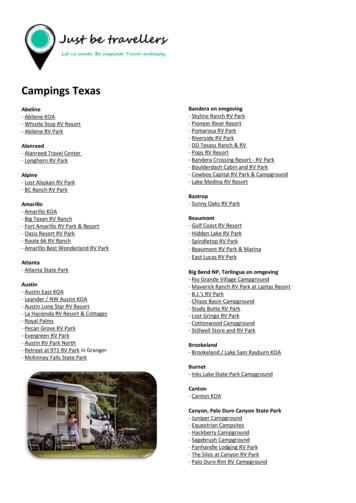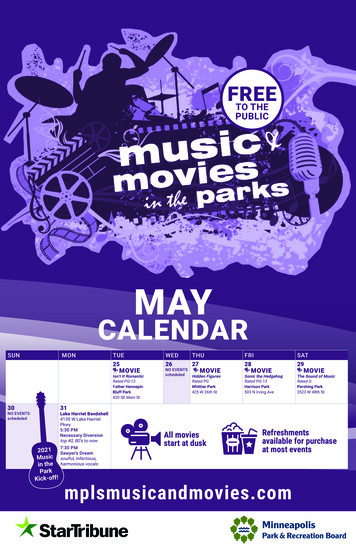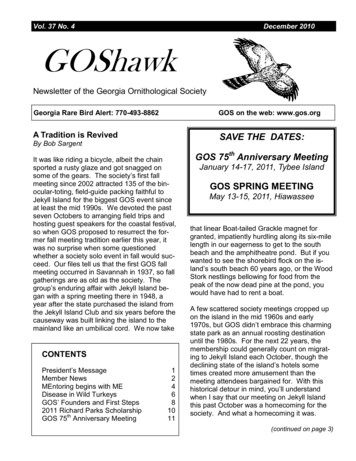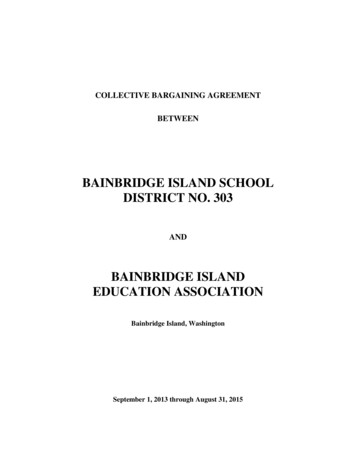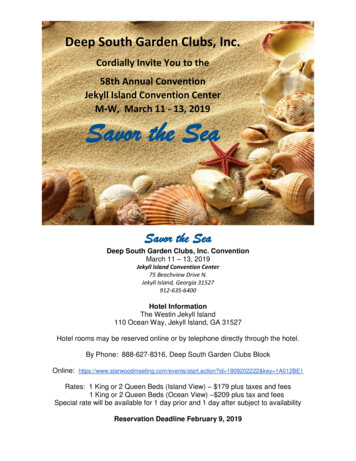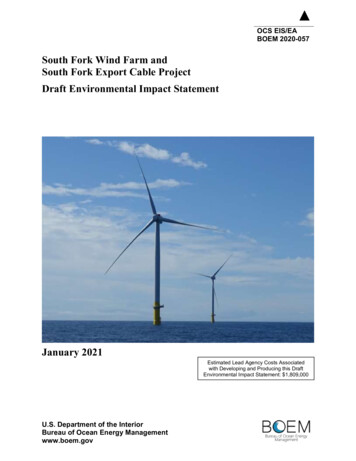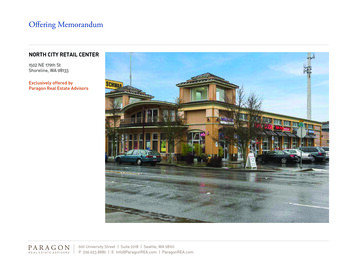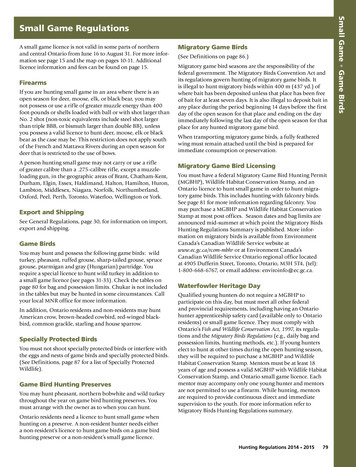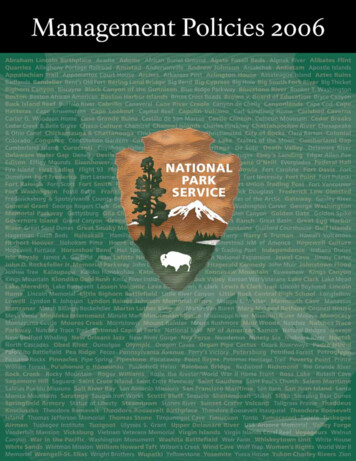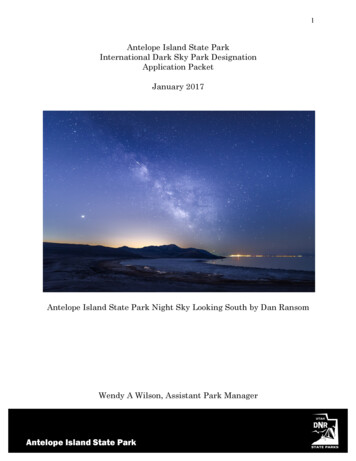
Transcription
1Antelope Island State ParkInternational Dark Sky Park DesignationApplication PacketJanuary 2017Antelope Island State Park Night Sky Looking South by Dan RansomWendy A Wilson, Assistant Park ManagerAntelope Island State Park
2Table of ContentsInternational Dark Sky Park SummaryNomination Letter from Janet Muir, North Fork ParkPark MapPark ResourcesEcologyGeological ResourcesHuman HistoryNatural Darkness ResourcesClimateLight PollutionNight Sky ResourcesPublic Leadership ProjectVisitor Experiences (Interpretive Programs and Outreach)Exterior Light Management PlanExterior Lighting InventoryLetters of SupportFred Hayes - Director, Division of Parks and RecreationJeremy Shaw - Manager, Antelope Island State ParkSteven Bates - Wildlife Biologist, Antelope Island State ParkJustina Parsons-Bernstein - Heritage , Interpretive and ADA Resources ManagerDavis County CommissionSyracuse City, ResolutionOgden Astronomical SocietyFriends of Antelope IslandAntelope Island State Park356889910131618202226324142434445464849
3Antelope Island State Park International Dark Sky Park SummaryAntelope Island State Park seeks designation as an IDA Dark Sky Park and aims toshow within this document that the land base, while flanked on the east side by theheavily populated Wasatch Front, meets the criteria for designation as a dark skyresource.Antelope Island State Park’s visitation in 2015 was over 320,000. The opportunityfor public nighttime access is available on a regular basis, with entrance gatesstaying open until 10:00 pm during spring, summer and fall months, and until 7:00pm during winter months. Numerous nighttime public programs are currentlyoffered year-round.Despite the extensively lit Wasatch Front which flanks the entire east side ofAntelope Island State Park, the west side of the island, due to the large mountainridge blocking the view to the east, and its overall remote nature, is a wonderfuldark sky resource.Philosophy: While Antelope Island State Park does not possess superior orexemplary nighttime landscapes associated with Gold or Silver designations, it doescertainly offer “people, plants, and animals a respite from a degraded nocturnalenvironment suitable for communicating the issue of light pollution and connectingpeople with the many aspects of the night sky.”We are in fact perfectly positioned to be able to have potentially major impacts onthe surrounding communities and businesses through outreach, education andpartnerships.After-Dark Access: The Park’s entrance gate closes automatically at 10:00 pmMarch 1 to November 1 and at 7:00 pm November 2 – February 28 (29). While thereis a set time for the gate to close, there is no set time for visitors to leave the park.Once in, they may stay until well after dark for night sky viewing and photography.The exit gate opens automatically upon exiting. Our gates remain open even onmajor holidays such as Thanksgiving, Christmas and New Year’s.Artificial Light and Skyglow: From the west side of the island, Antelope Island fallssomewhere in between Silver and Bronze requirements. Light domes do nottypically stretch to the zenith, though horizon sky glow is visible. However, “aspectsof the natural sky are still visible.”Antelope Island State Park
4Observable Sky Phenomena: Again, from the west side of Antelope Island, manysky phenomena can be observed. The Milky Way and the Andromeda Galaxy can bereadily observed, as well as satellites, and meteors.Nocturnal Environment: Lights within the boundary of Antelope Island State Parkare minimal with most areas casting only minor to moderate ground illumination.Numerous nocturnal wildlife species, including badgers, burrowing owls, bobcats,and coyotes are often found living and hunting near our buildings.Visual Limiting Magnitude: 6.1-6.5The limiting magnitude is the magnitude of the faintest star that can be seen. Thelarger the number, the fainter the star.Ogden Astronomical Society assisted in determining the Visual Limiting Magnitudefor Antelope Island State Park through the use of light pollution maps and data,and through their personal observation over several nights of presenting starparties on the Island.Bortle Sky Class: 4A semi-quantitative measure of the sky quality observed visually, as developed byastronomer John Bortle. Classes are whole numbers 1-9, with 1 the very best and 9the poorest.Ogden Astronomical Society assisted in determining the Bortle Sky Class forAntelope Island State Park through the use of light pollution maps and data, andthrough their personal observation over several nights of presenting star parties onthe Island.Unihedron Sky Quality Meter: 20.67Antelope Island State Park staff used a basic Unihedron Sky Quality Meter (SQML) to gather data during times of new (or close) moon. Staff measured sky qualityfrom 6 - 9 distinct sites within the park. Two (2) of those sites will be measured onlyonce per year, due to the difficulty in accessing those areas. The average of theseSQM-L measurements is 20.67. Park staff have committed to completing skyquality meter collection two to four times each year (more if possible) to monitor thequality of the night sky.Antelope Island State Park
5Nomination LetterAntelope Island State Park
6Map of Antelope Island State ParkGoogle image showing proximity to major cities along the Wasatch Front:Antelope Island State Park
7Park map showing major points of interest, trails and roads:Antelope Island State Park
8Antelope Island State Park ResourcesPark ResourcesAntelope Island State Park, located in northern Utah, is the largest island in theone million-acre Great Salt Lake. The 28,240-acre park (100% of the island is theState Park), in close proximity to the state’s largest population centers, providesopportunities for quietness and solitude and the chance to view an amazing varietyof wildlife in a natural setting.Visitors often comment and are pleasantly surprised by how close Antelope Island isto the city, and yet how remote, natural and isolated the park is and feels.The only land access to the island is via a seven-mile causeway that begins just eastof Syracuse, Utah. Antelope Island measures 15 miles long and seven miles wide atits widest cross-section. The elevation of the island varies from about 4,200 feetabove sea level at the lakeshore, to 6,596 feet at Frary Peak, the island’s highestpoint.Antelope Island is also within 25 miles of the most heavily populated counties inUtah – Davis, Weber and Salt Lake. The island is an important local recreationsource for these three counties.Antelope Island first became a State Park in 1969 when the northern 2,000 acreswere purchased by the state of Utah. In 1981, the entire island was purchased andturned over to the Division of Parks and Recreation for management. A visitorcenter was built in 1997, and several other amenities were constructed and/orimproved over the years since including three primitive campgrounds, beachrestrooms, showers and a concession-owned grill, access to the historic FieldingGarr Ranch, over 50 miles of non-motorized trails and bison corrals.EcologyAntelope Island is a signature sagebrush steppe community. Junipers dot therugged landscape of the higher regions. Shrubs such as sagebrush, rabbit brush,Shadscale, greasewood and buckwheat cover the majority of the island.Wildflowers include biscuitroot, stork’s bill, sego lilies, globe mallow, penstemon,several species of primrose and others.Wetlands surrounding the various springs on the island yield willows, rushes,sedges, watercress, nettles, cattails and phragmites. These plants provide vitalhabitat for many species of animals.Antelope Island State Park
9Native plants have suffered due to the many introduced noxious weeds. Themajority of these weed were introduced during its time of private ownership,however, extensive recreation use aids in the distribution of many of the seeds.Over 40 natural fresh-water springs and seeps provide water for wildlife andvegetation on the island. The majority of the springs are found on the east side ofthe island. Several canyons on the island are created by springs flowing throughcreeks. These areas support trees such as juniper, netleaf hackberry, big toothmaple, chokecherry, box elder, Russian olive and willows.The variety of plant life and fresh water springs supports numerous wildlife species,including mule deer, bobcat, coyote, pronghorn, black-tailed jackrabbit, cottontailrabbit, porcupine, skunk, ord kangaroo rat, meadow vole and bison. Over 250species of birds spend all or part of their lives on and around Antelope Island,including sensitive species such as burrowing owls, short-eared owls, andgrasshopper sparrows. Reptiles include sagebrush lizards, side-blotched lizards andwhip-tail lizards, as well as gopher snakes, blue racers and garter snakes.Geological ResourcesThe geological resources on Antelope Island are unique and expansive. AntelopeIsland has some of the oldest and youngest rocks in Utah. The oldest formation isthe Farming Canyon Complex dating to nearly 2 billion years old.Two-thirds of the island rock outcrops are comprised of the Farmington CanyonComplex. Most of these are classified as banded gneiss and are strikingly beautiful.Other rock formations include the Kelly Canyon Complex dating at about 750million years old, and Tintic Quartzite at about 500 million years old. The youngestrock is Tufa, a sedimentary rock that was deposited about 10,000-15,000 years agowhen the area was covered in a vast and ancient lake, known as Lake Bonneville,evidence of which can be seen on the mountain slopes in the form of ancientshoreline benches.Antelope Island is part of the Basin and Range District that stretches from theWasatch Front west to the Sierra Nevada Range. It is characterized by alternatingareas of raised ranges interspersed with lower valley basins. Antelope Island is partof the one of the ranges.Human HistoryEvidence exists that suggests Antelope Island has been used by humans forthousands of years. Archeological digs have yielded artifacts from the valley thatAntelope Island State Park
10date back as far as 10,000 years. Archeological investigations on the island have notbeen extensive, but the few studies and excavations completed to date indicate ahuman presence on the island as long as 6,000 years ago. The earliest known peopleto frequent the island were the prehistoric Archaic culture. These nomadic huntergather people used the area around Great Salt Lake from approximately 8,000 B.C.to A.D. 400.Retrieved cultural artifacts found on the island indicate that the Fremont culture(approximately A.D. 400 to A.D 1300) also used the island. These people haddeveloped some agriculture and lived in villages of pit houses around Great SaltLake.Other groups of people, including Northwestern Shoshone, Northern Utes, and theGoshute lived in the area near Great Salt Lake. These groups also used AntelopeIsland for hunting and gathering activities.The first documented European to visit the area was Jim Bridger. In the winter of1824-1825, Bridger and several companions followed the Bear River to the edge ofGreat Salt Lake and assumed it was an arm of the Pacific Ocean.In 1843, John C. Fremont extensively explored Northern Utah, including AntelopeIsland. Fremont published his reports and maps, and this information proved to bea significant factor in the decision of Brigham Young and LDS Church leaders tocome the Rocky Mountains/Great Basin area.Beginning in 1848 and continuing until the State of Utah purchased the island in1981, ranchers and homesteaders took up residence on the island. During this time,the island supported thousands of cattle, horses and over 10,000 sheep.In 1893, then owner John Dooley purchased 12 bison from William Glasmann whohad purchased the animals two years earlier from a Kansas rancher. These bisonwere relocated to Antelope Island and became the genesis of the bison herd thatroams the island today.Natural Darkness ResourceThe visual and aesthetic resources offered at the park are very important to thevisitor experience. The park is unique in that it can provide feelings of solitude andremoteness in a natural setting while being so close to the state’s largestpopulation.The 2004 Access Management Plan stresses protecting values of solitude, opennessand ruggedness. Sightseeing and wildlife viewing were the most participated inAntelope Island State Park
11visitor activities listed in the 2000 and 2007 survey of park visitors. Thus,protecting the aesthetic and natural resources of the park are a high priority. Andwhile darkness is not specifically listed as a natural resource to protect, recentsupport from the Division Director, Northern Region Manager and AntelopeIsland’s current Park Manager, verify protecting darkness is one of the values thepark seeks to maintain and enhance. Impacts that degrade these experientialvalues may also harm wildlife, plant life and soils.Within the 2009 Resource Management Plan, under the section dealing withrecommendations is the following:“Preserve the visual and aesthetic values of the park such as the concepts ofsolitude, openness and ruggedness.”Within that section is the following:“The 2004 Access Management Plan team recognized the unique resourcesand experience Antelope Island offers. In particular, the team mentioned theisland’s ability to offer the feeling of solitude and remoteness in a naturalsetting in close proximity to the state’s largest population center. The accessteam specifically stressed protecting values of solitude, openness andruggedness.”“Monitor implementation of access plan for impacts on island resources andvisitor experiences, and if monitoring indicates that resources or experiencesare being degraded, the park will take actions to mitigate impacts.”While dark sky resources are not specifically mentioned, Park Management hasindicated that darkness is indeed a park resource to be protected as indicated by theletters of support included in this packet (specifically see Park Manager letter page42).Additionally, the Board of Parks and Recreation has recently issued a resolutionregarding Dark Sky designation in Utah State Parks:Board of Parks and Recreation Resolutionto Support Dark Sky Designation for Appropriate Utah State ParksWHEREAS the dark skies at many of Utah's state parks are among the darkestnight skies in the United States,Antelope Island State Park
12WHEREAS natural dark sky areas are decreasing around the country and takingsteps to enhance this resource in Utah's state parks provides parks with anadditional avenue to draw visitors—including during shoulder seasons,WHEREAS many of the parks within the Utah Division of Parks andRecreation recognize and promote the value of dark skies,WHEREAS visitors to Utah's state parks appreciate the pristine night skies weoffer,WHEREAS night sky programs offered at Utah's state parks are among the mostpopular interpretive programs,WHEREAS many parks are interested in pursuing International Dark Sky ParkDesignation,THEREFORE, BE IT RESOLVED that the Board of Parks and Recreation supportsthe efforts of parks within the Utah Division of Parks and Recreation to pursuedesignation as International Dark Sky Parks and to manage and enhance thisresource for the enjoyment and edification of the public.!!In addition, until a new Resource Management Plan is created for Antelope IslandState Park, the following Addendum has been created by Utah State Parks, andsupported by Board of Parks and Recreation:Resource Management Plan Dark Sky AddendumBackgroundUtah's state parks have some of the darkest, most pristine skies in the UnitedStates. Many parks are interested in enhancing and promoting this particularnatural resource to enrich current visitor experience and attract new patrons. Darksky management includes regulating outdoor night lighting fixtures to preserve andenhance the park’s dark sky while promoting safety, conserving energy, savingmoney on electricity bills and promoting night sky programming year-round. With asolid dark sky management strategy in place, parks can pursue International DarkSky Park Designation which is a way to certify their efforts to effectively managethis natural resource.Current StatusParks interested in diversifying their visitors’ recreational offerings by enhancingthe views of their pristine night skies and in pursuing International Dark Sky ParkAntelope Island State Park
13Designation need to add dark sky management to their Resource ManagementPlans. Redoing an entire Resource Management Plan is a time-consuming andcostly undertaking. Therefore, adoption of this Dark Sky Addendum by each parkinterested in managing their night skies at an internationally-recognized level ofquality will suffice until such time as the park has cause to redo their managementplan in its entirety. At such time, Dark Sky Management would be expected to beincorporated into the main body of the park’s Resource Management Plan.Board RecommendationWe request that the Board of Parks and Recreation approve this Dark SkyAddendum for parks pursuing International Dark Sky Park Designation as anaddition to their current Resource Management Plans.ClimateThe climate on Antelope Island is temperate and arid, with annual precipitationaveraging about 18 inches. From June through early September thunderstormsadvance from the Pacific Ocean off the coast of Mexico and southern California.Frontal-type storms out of the northwest move through the areas from Octoberthrough June.The island’s precipitation is spread throughout the year, averaging more than oneinch per month, except May, June and July. December is the wettest month,averaging 2.99 inches. July averages only .09 inches of precipitation. Summertemperatures vary approximately 30 F with highs around 90 F and lows around 60F. Winters have a temperature range of about 20 degrees F, with highs in the upper30s and lows of about 20 F. Annual snowfall averages just 10 inches from November– March or April.Antelope Island State Park
14PrecipitationAntelope Island State Park
15Wind SpeedWind storms kick up a lot of debris and sand from the exposed lake bed surroundingAntelope Island. Occasionally, wind speeds can reach up to 80 mph (and sometimeshigher) as they move across the lake. Antelope Island’s average wind speed is justunder 6 mph. Lower average wind speed results in a reduction of air particlescommon in wind storms.Antelope Island State Park
16Light PollutionLight pollution limits the visibility of astronomical features, such as the Milky Way,nebulae and galaxies, and raises the noise on CCD astrophotography. Dark skiesare important for astronomical observations, and human and wildlife health andsafety.This map shows a small excerpt from www.lightpollutionmap.info. It shows themost recent (2016) measurement of light pollution affecting Antelope Island fromthe Wasatch Front, and other areas around Great Salt Lake. It also shows areas ofAntelope Island that are less affected by the surrounding light pollution, andindicate quality dark sky areas of the park.It’s important to note that the majority of light pollution affecting Antelope Islandcomes from outside sources. Minimal light pollution originates from the Park itself.(Radiance overlay from March 2016)Antelope Island State Park
17The map to the left showsradiance overlays from one yearago, March 2015. Note thedecrease in light pollution overthe Island from 2015-2016.Lighting on Antelope Islandis extremely minimal,producing very little lightpollution. Only a couple ofareas within the park havecontinual night lighting,including the public beachrestrooms and the marina.Night sky measurementswere taken from 6-9 areas ofthe park at different timesthroughout the year in 2016using a Unihedron SkyQuality Meter (SQM-L).Areas of measurementincluded the east side whichis more affected by lightpollution from the city, aswell as from the darker westside, with much less lightpollution impact.(Radiance overlay from March 2015)Antelope Island State Park
18Night Sky DataAverage SQM-L reading for Antelope Island State Park: 20.67During 2016, Park Management worked with the Ogden Astronomical Society todetermine the quality of the night sky at Antelope Island State Park.Park Management took SQM-L readings over the course of the year from 6-9 sightseach night. A summary of those measurements is below:Night Sky Data – Main Data PointsWhiteBB #8Rock lN 41º 01.506W 112º 14.395N 41º 02.390W 112º 15.731N 41º 02.901W 112º 9N 41º 03.492W 112º 15.01720.8820.7520.53Night Sky Data – South and Backcountry Data PointsLone TreeFielding GarrRanchN 40 59.395W 112 13.32310/25/201612/28/201620.70Could Not MeasureN 40 55.554W 112 10.15420.5120.25MarinaUpperFraryN 41º 03.643W 112º 14.383N 41º 59.627W 112º 12.15120.8620.6720.4820.8420.59Could NotMeasureBuffalo ScaffoldTrailMoon PhaseNew 0%Waxing 18%New 0%Moderate Inversion/HazeMoon PhaseN 40 55.652W 112 13.24520.59Could Not MeasureWaxing 18%New 0%Moderate Inversion/HazeIn addition to SQM-L readings, the Odgen Astronomical Society assisted the park indetermining the Visual Limiting Magnitude and the Bortle Sky Class through theuse of light pollution maps and data, and through personal observation over severalnights of presenting star parties on the Island.Year2016SQM-L20.67Antelope Island State ParkLimiting Magnitude6.1 - 6.5Bortle Class4
19The following images were taken from the ridge between Dooley Knob and FraryPeak, an area offering very good views of both the east and west sides of the island.These images show the overall darker landscape and night sky on the west side ofthe island due to the prominent ridge line running north to south, blocking themajority of the west side from the city lights (taken with Nikon DSLR 5 secexposure).NorthEastSouthSouthWestNorthNight sky photographers often come to Antelope Island State Park for astrophotography. The following two images were captured from Buffalo Point by JeremyPoorte of Blissful Light Images.Looking south towards I-80, Garfield City and Lake Point City.Antelope Island State Park
20If designation as a Dark Sky Park is granted, the Assistant Park Manager, assistedby the Park Naturalist, will conduct ongoing sky brightness measurements two tofour times per year and include that information in the annual report.Public Leadership Project (s)Park Management has met with Syracuse City (the gateway city to the park) andDavis County to discuss our dark sky application and efforts. Davis CountyTourism has committed to helping with funding our Dark Sky brochure, outreachefforts with local business, promotions through the school district, and generalpromotion of Dark Skies through websites and social media.In addition, our Assistant Park Manager has been in contact with members of DavisCounty Facilities Department to discuss the lighting owned by them within closeproximity to the State Park, which includes the parking lights at the entrancestation, as well as those at the Army Ranger Memorial. We have discussed theoptions of removing and/or changing out much of that lighting. Davis County hascommitted to find funding to retrofit those lights from metal halide bulbs to lowKelvin LED bulbs.Syracuse City Managers were thrilled with the opportunity to meet and discussdark skies. As a direct result of this meeting, the Syracuse City Council recentlypassed a resolution (see page 47) supporting our efforts in becoming anInternational Dark Sky Park, as well as continuing their commitment toresponsible lighting through regulatory powers (see Syracuse City Outdoor LightingOrdinance, page 30).Park Management developed a power point presentation along with talking pointsto present to any organization that expresses an interest through these and otheroutreach efforts. The focus of the presentation is both educational and to encourageparticipation in dark sky activities.The Manager and Assistant Park Manager met with Friends of Antelope IslandState Park to update them about Dark Sky Resources. Friends of Antelope Islandissued a letter of support and will continue to assist the park through fundingvarious dark sky projects as they relate to improving the visitor experience at thepark.Finally, Park Staff developed a Dark Sky brochure (printing funded by DavisCounty Tourism) addressing light pollution and the value of dark skies. Thisbrochure is available to park visitors and will be distributed by Davis County toseveral businesses and schools within the area. See brochure belowAntelope Island State Park
21Antelope Island State Park
22Visitor ExperienceNight Sky Interpretive Programs and Outreach at Antelope Island State Parkinclude the following: ! Dark Ranger on Staff (Astronomical Society of the Pacific/Astronomy Fromthe Group Up program). ! Ogden Astronomical Society offers monthly summer star parties. ! Park staff offers evening interpretive programs throughout the year. ! Park staff offers guided full moon, new moon, constellation and sunset hikes. ! Astrophotographers come occasionally to photograph the night sky. ! Access to the park after dark year-round for night sky viewing (see AfterDark Access, page 3). ! Developed an Antelope Island State Park brochure addressing dark skies. ! Plans to install permanent Dark Sky Interpretive information at White RockBay and the Visitor Center.The following are samples of some of the astronomy/dark sky/evening programsoffered at Antelope Island State Park.January 20, 2012Astronomy Program: The Winter Hexagon. Bright winter stars are out high in thesky, with stories just waiting to be told. The Winter Hexagon is where it all begins.Meet at 5:30 pm in the visitor center. Dress to spend time outdoors. If you bring aflashlight, be sure it has a red filter. For more information, call (801) 721-9569.February 18, 2012Astronomy Program: The Life of Stars. The stars we see at night are all in variousstages from “birth” to “death”. Come and explore the night sky as we discuss andobserve the life cycle of stars. Meet at 5:30 pm in the visitor center. Dress to spendtime outdoors. If you bring a flashlight, be sure it has a red filter.June 5, 2012Transit of Venus: Solar Viewing. Join park staff and members of the OgdenAstronomical Society for a rare event. A transit occurs when Venus passes directlybetween the sun and the earth. The most recent transit of Venus was in 2004. TheJune 5, 2012 transit of Venus will be the last time this event takes place until 2117.Stop by the Visitor Center any time after 4:30 pm until sunset to view the sunthrough special solar viewing glasses solar telescopes. Never look directly at thesun. For more information call (801 721-9569.June 15, 2012Sailing Astronomy. Meet with the Park Naturalist at 9pm at the Great Salt LakeAntelope Island State Park
23Marina for an evening learning about our starry night. This is “un-aided eye”astronomy, what you might gaze at and see while you are sailing, or sprawled outon a blanket looking up at the sky. We will talk about how big space is, the life of astar, and other night sky topics. We will then talk about and learn how to identifyseveral summer constellations and many of the stories behind them. Park entrancefees apply. For more information call (801)721-9569.January 11, 2013Astronomy Program: The Solar System. Earth is just one of the many objectsorbiting our sun. What else is out there and just how big is it? Join the ParkNaturalist at 7 pm in the visitor center to learn all about our cosmic neighborhood.Dress to spend time outside. Park entrance fees apply. For more information call(801) 721-9569.February 8, 2013Astronomy Program: Life of a Star. Join the Park Naturalist at 7:00 pm in thevisitor center to talk about some of the many wonders of the night sky. We’ll talkabout the life stages of a star, and then bundle up and head outside to findexamples of those things in the cold winter sky. Dress to spend time outside. Parkentrance fees apply. For more information call (801) 721-9569.March 8, 2013Astronomy Program: The Winter Hexagon. Bright winter stars are out high in thesky, with stories just waiting to be told. The Winter Hexagon is where it all begins.Meet at 7:00 pm in the visitor center. Dress to spend time outdoors. If you bring aflashlight, be sure it has a red filter. Park entrance fees apply. For moreinformation, call (801) 721-9569.April 12, 2013Sunset Hike: Buffalo Point. Meet at the Buffalo Point Overlook parking lot at 7 pmto experience one of Great Salt Lake’s breathtaking sunsets from the top of BuffaloPoint, a ½-mile hike with about 600 feet elevation gain. We will talk about whatlives in this desert habitat. Dress for the weather and wear sturdy shoes. Parkentrance fees apply. For more information call (801) 721-9569.January 15, 2014Full Moon Hike: Lakeside Trail. Join the Park Naturalist at 6 pm at the LakesideTrailhead (Bridger Bay Campground site #8) for a 5 mile round trip hike under thelight of the full moon. We will discuss nocturnal adaptations, night vision and otherevening topics. Entrance fees apply. For more information, call 801-721-9569.March 21, 2014Astronomy Program: Hot Tub Astronomy. Enjoying the night sky does not requireAntelope Island State Park
24telescopes, fancy equipment or vast knowledge. You can do it from the comfort ofyour hot tub, lawn chair, or simply lying on a blanket. Join the Park Naturalist at 8pm in the visitor center for a discussion on the night sky followed by night skyviewing. Dress to spend time outside. Entrance fees apply. For more information,call 801-721-9569.April 5, May 3, June 21, 2014Star Party. Join members of the Ogden Astronomical Society in White Rock Bay asthey set up telescopes for deep space viewing. Learn about globular clusters,nebulae, galaxies and more. Beginning at 6:
vegetation on the island. The majority of the springs are found on the east side of the island. Several canyons on the island are created by springs flowing through creeks. These areas support trees such as juniper, netleaf hackberry, big tooth maple
